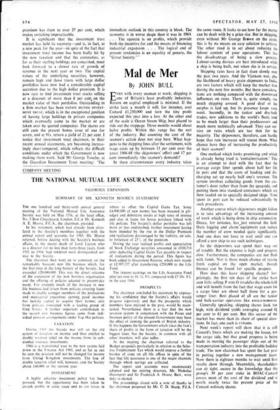Mal de Mer
By JOHN BULL
VEN with every seaman at work, shipping is _Cone of Britain's least profitable industries. Return on capital employed is minimal. If the strike lasts a month it will, for instance, cost Cunard £1,250,000 and turn the tiny profit expected this year into a loss. At the other end of the scale is Ocean Steam Ship, best placed to ride out the stoppage. Three months would about halve profits. Within this range lies the rest of the industry. But counting the cost of the seamen's action does not stop here. What hap- pens to the shipping lines after the settlement, with wage costs up by between 13 per cent over the years 1966-68 (the shipowners' offer) and 17 per cent immediately (the seamen's demand)?
In these circumstances every industry takes
the same route. It looks to see how far the matter can be dealt with by a price rise. But in shipping, even without Mr George Brown on the scene, this is by no means an easy solution to achieve. The other road is to set about reducing the labour content ' of your operations. This has the disadvantage of being a slow process. Labour-saving devices are best introduced while a ship is being built, not when she is in service.
Shipping rates have in fact risen slowly over the past two years. And the Vietnam war, plus the likelihood of heavy grain shipments to India, are two factors which will keep the market firm during the next few months. But these considera- tions are nothing compared with the downward influences on rates. There is, quite simply, too much shipping around. A good deal of the surplus is laid up, but its presence keeps rates weak. Secondly, in the tanker and dry-bulk trades, new additions to the world's fleets tend to be much larger than their predecessors and much more technically advanced. They can sur- vive on rates which are too thin for the majority. The shipowners, therefore, can hardly hope that rate increases will rescue them. What chance have they of increasing the productivity of their seamen?
One method which looks promising and which is already being tried is 'containerisation.' This is an attempt to deal with the fact that the average cargo liner spends about half her life in port and that the costs of loading and dis- charging eat up nearly half one's revenue. The system involves collecting goods from the cus- tomer's door rather than from the quayside, and putting them into standard containers which are then loaded on to specially designed ships. Time spent in port can be reduced substantially by such procedures.
Another course which shipowners might follow is to take advantage of the increasing amount of work which is being done in ship automation. Decca, for instance, hasjust entered the field. Data logging and alarm equipment can reduce the number of crew needed quite significantly. And one does not have to wait until one can afford a new ship to use such techniques.
So the shipowners can spend their way out of trouble. But the expense is high and progress slow. Furthermore, the companies are not flush with funds. Nor is there much chance of raising fresh capital on the open market, though finance can be found for specific projects.
How does this leave shipping shares? Sur- prisingly, the first ten days of the strike have seen little selling. P AND 0 straddles the whole field and will benefit from the fact that wage costs for a cargo liner are about half those for a pas- senger liner. Best placed of all are the tanker and bulk-carrier operators like AIVGLO-NORNESS.
Generally speaking, shipping shares look too high, with dividend yields averaging around 6i per cent to 61 per cent. But this sector of the market has more than its share of special situa- tions. In fact, one such is CUNARD.
Next week's report will show that it is still Cunard's liners which are making the losses, not the cargo side, but that good progress is being made in moving the passenger ships out of the transportation industry into the profitable holiday trade. The new chairman has spent the last year in putting together a new management team. Now there is eighteen months to wait until first results show through. Meanwhile, shareholders can sit tight, secure in the knowledge that the group's 30 per cent stake in BOAC-Cunard covers most of the cost of the dividend and is worth nearly twice the present price of the Cunard ordinary shares.


































 Previous page
Previous page